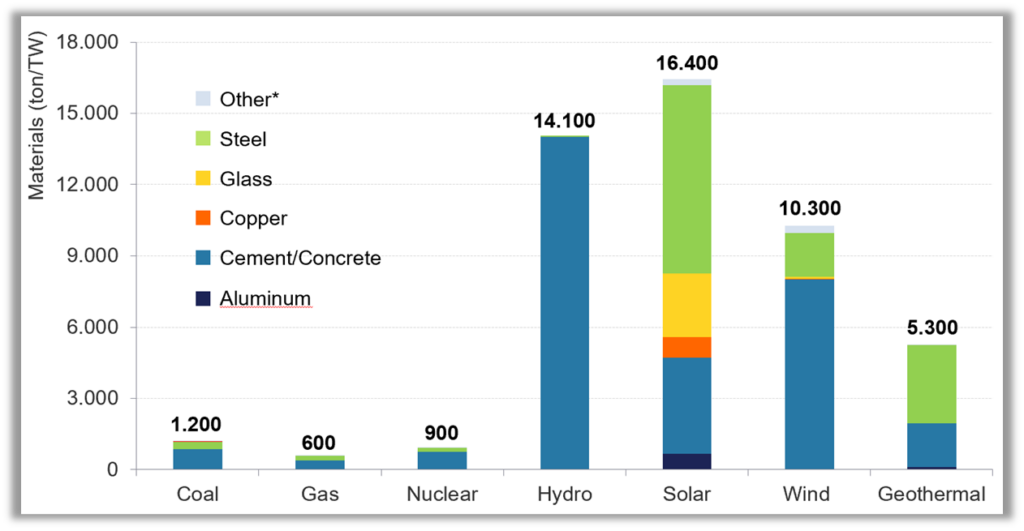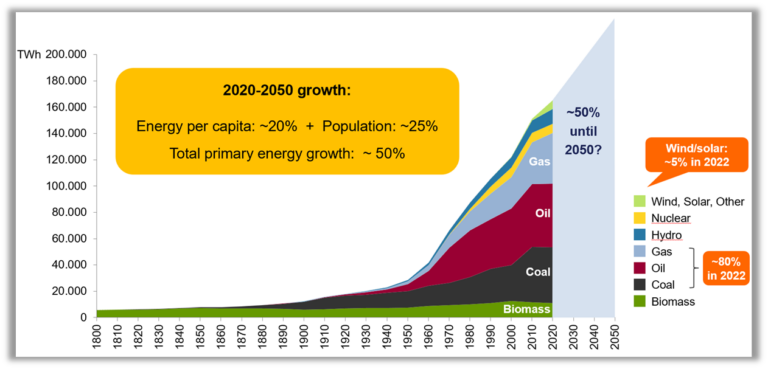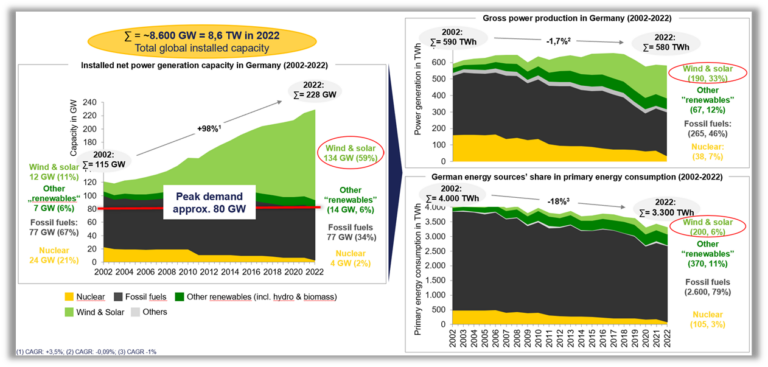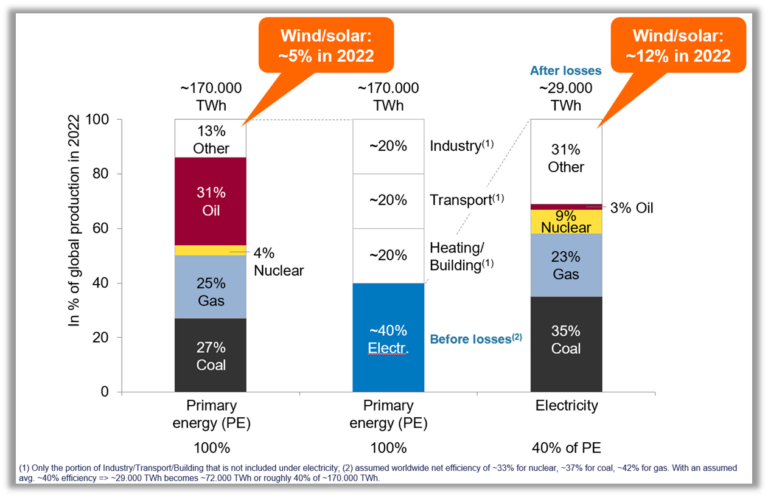Many an engineer or people with energy related education or work, continue to make the argument that electrification of heating, transport, and industries will increase energy efficiencies and therefore reduce primary energy use. For example, the IEA projects in their “net-zero pathway” a reduction of 10% in primary energy use by 2030 and even more by 2050 despite population increase and rising living standards with logical energy per capita increases in the fast growing “Global South”
Assuming a 25% population increase, and 20% per capita energy increase would more realistically translate to an approximate 50% primary energy increase by 2050 (Figure 1). This would put the world average in 2050 roughly on par with China today, far behind Europe or the US, and it also assumes that the net energy efficiency for “production” and “consumption” of energy remains roughly unchanged from today until 2050. Why the assumption about constant primary energy efficiency may be challenged by some, I attempt to explain here.
Figure 1: Primary energy until today and projection to 2050. Sources: Schernikau based on Our World in Data based on Vaclav Smil 2017 and Energy Institute Statistical Review of World Energy 2023, (link)
Electric engines are more efficient than internal combustion engines, heat pumps are more efficient than oil or gas burners. Using electricity to make industrial heat is more efficient than combusting fossil fuels. These are just some of the arguments we regularly hear, also extending to hydrogen. And here appears to be proof: Germany’s primary energy use has fallen about 20% during 20 years of the “Energiewende”, while the standard of living, population, and electricity consumptions hasn’t changed much (Figure 2)
It is correct that an electric engine is more efficient than an internal combustion engine, why else would our modern trains be electric and not diesel driven anymore? It is also correct that “moving” energy from one place to another to raise your temperature by 1 °C (i.e. from the ground to your electric heater using a heat exchanger) will on average only use about one third of the energy required compared to combusting oil or gas.
I don’t know enough about and haven’t researched industrial heating sufficiently to comment, so I will leave that one out for today, but it doesn’t make a difference to my argument here. However, the making and use of Hydrogen as an energy carrier is certainly NOT energy efficient, I hope this is not up for discussion.
Why do these above-mentioned energy economic facts about electric engines and heat pumps not translate to less primary energy use, but quite the contrary? Why is there a fundamental misunderstanding about how primary energy is required to run our lives, electric or not? Let us delve into it and have a look.
Figure 2: German installed power capacity, power generation, primary energy. Sources: Schernikau based on Fraunhofer, Agora, AG Energiebilanzen. See also www.unpopular-truth.com/graphs.
- What is Primary Energy
Primary energy is “raw unprocessed energy” we extract from nature
(Lars Schernikau)
Discussions about the use of the primary energy metric have emerged as “renewables” such as wind and solar are making up a larger share of electricity but a lower share of primary energy, as you can see in Figure 2 and 3. Some economists consider primary energy outdated and misleading because they consider that “primary energy” from solar and wind can be converted to usable electricity with little energy losses.
For this important discussion, we clarify that globally ~70.000 TWh primary energy is used for electricity generation (around 40% of primary energy) which translates to ~30.000 TWh of usable electricity (Figure 3). This difference largely results from the thermal conversion, or (in)efficiency, of conventional fuels to electricity in thermal power plants.
Wikipedia states, in my view correctly “Primary energy (PE) is the energy found in nature that has not been subjected to any human engineered conversion process. It encompasses energy contained in raw fuels and other forms of energy, including waste, received as input to a system. Primary energy can be non-renewable or renewable.”
To confuse the matter further, there are different ways of calculating primary energy: the partial substitution method and the physical energy content method (see OurWorldInData or IEA FAQ), but this technical point is also not relevant for this discussion here.
So why then do I make a fuss about it and dispute that an “electric world” based on wind and solar (forms of primary energy) would require less total primary energy as the IEA and many others suggest?
Firstly, I argue that the way primary energy is calculated on a country by country basis is misleading at the least, because it leaves out the primary energy consumed outside of the country! That is why you see an – incorrect – reducing of primary energy consumption in Germany.
Secondly, I argue the way that wind and solar show up in the energy statistics, with little energy loss or with little impact on primary energy, is misleading if not wrong. The standard interpretation of published electricity and primary energy data, i.e. wind and solar are more primary energy efficient, is simply inconsistent with physics and energy economics.
Figure 3: The “use” of global primary energy and comparing it to electricity. Sources: Schernikau based on IEA, Energy Institute (ex BP), Our World in Data. See also www.unpopular-truth.com/graphs.
2. Primary energy from “mined fuels” vs. primary energy from sun and wind
For this discussion I will leave out hydro and biomass. Hydro resources are limited, and biomass has other significant environmental and economic impacts, that I will not discuss here in the interest of time. I focus on:
a) so called “non-renewable” energy from “mined fuels” oil, coal, gas, uranium making up almost 90% of primary energy and about 70% of electricity, and
b) so called “renewable” energy from the sun and the wind claiming to make up about 5% of primary energy and 12% of electricity (Figure 3).
Let us get something straight upfront, oil, coal, gas, and uranium are “mined fuels” that we extract from the ground and logically there is a limit to what Mother Earth has available. Please accept that we don’t need to argue this point right now. I don’t see a concern for a few hundred years based on what we know today and based on the fact that we continuously find new resources.If you are over 50, do you remember what you were told in grade school about how long oil will lasts? Compare this number to today.
By no means am I proposing that we should not be concerned about mineral depletion. Such depletion translates to higher costs and logically more impact on the environment as the resources will be more difficult to “find” and “mine”. This can be witnessed in everyday life in the fuel extraction industry. Additionally, mined fuels are and always will be limited. How relevant this is to our lives depends on the total (I claim largely yet unknown) resource base and our annual extraction.
The current energy content of the total (today known) conventional fuel resource base is about 150 Mln TWh vs about 160.000 TWh annual extraction (BGR 2023). If these numbers don’t change and there truly were to be only 150 Mln TWh of conventional fuels in the ground, and if we find ways to economically extract these, we have about 900 years of “mined fuels” left at current extraction rates before the lights turn off. I know this sounds more than you think, but I invite you to check the numbers, I am speaking of known resources, not reserves.
The primary energy from fuels such as oil, coal, or gas is measured by their “inherent” energy, or calorific value, or combustion value usually in kcal/kg or btu or something similar. This primary energy contained in the “mined fuels” is “free” from nature but of course requires significant effort
a) to be extracted from the ground, to be processed, and transported, and
b) to be “converted” into usable valuable electricity by combusting it. Everything results in “energy loss” as entropy increases every time we touch or store energy.
As for the so called “renewable” energy from the sun and the wind, I would indeed agree that we have “almost” unlimited energy from the sun and maybe slightly more limited energy from the wind. Wind as a global power resource, is estimated to lie between 45 and 100 TW (Adams and Keith 2013). This compares to less than 9 TW of current global installed electricity capacity of all types, so all is good? Maybe not!
We understand that the 1st law of thermodynamics also applies here, energy is never lost only “moved” or “transferred” from one form to another. So naturally, as we “take” wind from the air to convert it to electricity, we are slowing down wind speeds. Such wind speeds will be “replenished” in time and the energy restoration rate ERR for wind tells us that about 1 to max 2 MW/km2 are available for “renewable” human use, otherwise the wind stops (Smith and Schernikau 2023 for more details and third party sources).
This low “power density” of wind comes with a primary energy consequence as you will see. When we speak of “energy losses” we of course don’t actually “lose” any energy but entropy increases and we just convert the initially “useful” energy to “useless” energy ending up in the form of heat naturally warming the world around us.
Sun’s power density per m2 is also limited by nature, not only by a) how long the nights are or how cloudy it is, but also b) by the solar irradiance or the “power of the sun shining on your head”. There is a difference between when you are standing in the bright mid-summer sun at noon in Arizona or in Northern Canada. Again, this low power density of about 5.000 to 10.000 kWh per installed kW per year in Germany vs. Arizona (Global Solar Atlas) has a direct consequence for primary energy
You will now hopefully agree that it takes energy, mineral resources, land space, and money a) to extract the „free” energy from nature, „renewable” or not, and b) to make the “extracted energy” usable for the final consumer in form of a consumable kWh or heat.
This is fundamental for the energy discussion:
While the primary energy is free for us to collect (mined or “renewable”), we always need to spend energy, mineral resources, land space, and money to (a) extract this energy and then (b) process it for final use.
3. Primary energy required to make wind and solar useful
It might be a surprise to you that the calculation of primary energy in Germany assumes that almost 100% of the electricity “harvested” or extracted from the sun or wind translates to usable electricity for the consumer. Thus, Germany in 2022, reported almost 200 TWh primary wind and solar energy ends up as about 190 TWh of consumable electricity in the statistics (AGEB Jahresbericht, p43). While for nuclear, 105 TWh of primary nuclear energy translated to about 35 TWh of electricity consumed, much less, than what you hear about of course.
Can you see the fallacy? Didn’t we just “agree” in the previous section that we have to include the energy a) to extract the energy from nature and b) to make the “extracted energy” usable for final use by the consumer? Funny enough we included b) in the gas example but we did not include a) or b) in the sun or wind example. Where did this go wrong?
a) Energy to extract the energy from nature: Let us stick with solar and gas in Germany to illustrate the point. The primary energy it takes to extract solar energy from nature you can find reported on largely in China’s statistics. 80-90% of the value chain for solar panels is based in or around China. Thus, the heat and electricity required to produce polysilicon, the glass, the aluminum, the copper, the chemicals, the steel for the mounting structure will be largely based on coal and again is largely but not only “accounted” for in China’s statistics. I have written an entire blog entry on this issue (Coal’s importance for Solar panel manufacturing) and a new yet unpublished academic paper is in the making (Mariutti and Schernikau 2024).
Of course, the same is true for what is required to build a gas-fired power station and it also has to be considered (which it currently is not done in Germany). The gas itself of course is accounted for. You may not be surprised that the low energy density of solar (and wind) means that much more land is required for solar but also that many more tons of materials are required to build installed capacity of solar or wind vs. gas or coal or nuclear for that matter (Figure 4).

Figure 4: Selected materials required by electricity generation technology. Source: Schernikau based on Department of Energy DOE, USA. See also www.unpopular-truth.com/graphs.
b) Energy to make the “extracted energy” usable for use by the consumer: The energy to make solar energy truly “usable” for final use is yet another more complex issue, which differs from gas, as you could “simply” estimate the power plant efficiency to get a rough number.
However, grid electricity from solar panels has much less value on its own for “normal” use as it is intermittent, unreliable, and thus unpredictable, at least at grid or utility level. You require additional installations to make a kWh from solar truly useful in the grid, these include (all compared to a single gas-fired power station):
- A large overbuild of solar panels to make up for low natural capacity factors (10 to 11% in Germany, 25% in California) + overbuild to “charge” storage + overbuild to account for energy “losses” not only required for storage but also conditioning, balancing, and transmission.
- Short duration energy storage (i.e., batteries) to overcome short-term intra-day fluctuations.
- Long duration energy storage (i.e., hydrogen?) to overcome days, or even weeks without “usable” sunshine, also called seasonal storage.
- A thermal power plant on standby for bad times, at least currently included in Germany’s plans.
- A much more complex and larger network integration and transmission infrastructure to integrate the solar power into the grid.
While I realize that not all 5 are required all the time, at utility scale or grid scale in fact they often are required and planned for. These 5 points become more critical the more wind and solar you have in the system.
Thus, wouldn’t you need to include the primary energy required for all of the above 5 points to make extracted solar energy “usable” for final consumption by the consumer? Would this not make the numbers comparable to that of a gas or coal-fired power station? We call such “usable” energy “dispatchable” energy or “firm” power, which means energy available on demand, not just when nature desires to give it to you.
A gas-fired, coal-fired, and largely also the nuclear power plant don’t require these 5 systems, as they are by nature largely dispatchable (less so for standard nuclear, but nuclear base load has a very different quality and value than intermittent wind and solar power). There is enough energy economic literature that also proves that every additional kWh of solar or wind, beyond a certain relatively small penetration level, has less value than the previous one (i.e., Hirth 2013). Thus, the full cost of electricity increases with every additional solar panel or wind turbine in the system.
The primary energy for making the extracted solar energy truly usable is certainly not accounted for in any single country statistics, but such energy would be counted in the country where all this equipment is manufactured or produced. Also, the embodied – largely fossil – energy for all required raw materials would have to be included and is accounted for somewhere else in the world, but not in Germany. (consider iron ore, limestone for cement, copper ore, lithium ore, nickel ore, bauxite, crude oil, and so much more).
This means that the share of primary energy required to make wind and solar ready for consumption is underestimated, and the share of primary energy required to make coal, gas, or oil ready for consumption is logically overestimated.
4. Now what?
Well, let’s summarize. We understand that currently solar and wind’s share in primary energy is vastly understated as it assumes that 100% of the primary solar and wind energy is converted to usable electricity in the grid. The true energy and raw material impact of wind and solar is “hidden” in the primary energy required for a) extracting the solar and wind energy and b) making the generated electricity truly usable by the consumer. The same “misstatement” also applies for usable energy from coal, gas, or oil, but its impact is significantly smaller as the fuel consumption is more significant than the capital equipment and the ancillary requirements for overbuilding, storage, and transmission either does not exist or is much smaller (remember the list of 5 systems). Also, the power density per m2 is much higher for conventional fuels, requiring far less equipment to do the job.
Thus, wind turbines and solar panels come with a lot of baggage not shown in the statistics. At global scale you will see how primary energy grows with more wind and solar. In fact, the net energy efficiency (eROI) of wind and solar, considering the entire system to make the electricity truly usable, is much lower than that for coal, gas, or nuclear. Therefore, as wind and solar penetration levels increase, you can expect primary energy to increase even faster. This is dictated by the “true full system eROI” which is lower for wind or solar than for conventional power systems. Again, we are working on a bottom-up academic study showing this. A top-down glimpse is available at Schernikau, Smith and Falcon 2022 “Full Cost of Electricity ‘FCOE’ and Energy Returns ‘eROI’”.
As for the electric vehicle argument. Yes, an electric engine is more efficient than a combustion engine, but only when directly compared without honestly taking the whole lifecycle into account. Feeding the EV with wind and solar power means this EV comes with all the baggage we discussed above and the benefit of the electric engine itself is “lost” (which an electric train powered by coal, gas, or nuclear doesn’t have). In addition, you have the battery issue, all the primary energy to make the battery (which an electric train doesn’t require) that – once manufactured – still has to be charged from the grid. Thus, at scale, EVs will not reduce primary energy. Electric vehicles may still make sense for selected specific applications, such as short distance commercial travel in or around cities, but I haven’t done the calculations, so this is just a conjecture. We disregard here the difficulty of selling used vehicles in the open market.
The same now applies to the heat pump. Every heat pump requires electricity, which a gas or oil heater requires much less of. Logically, we are told, that electricity should be “renewable”, largely envisioned from wind or solar. The efficiency gained by the heat pump technology is lost by the inefficiency of the wind and solar system. In addition to that, you have the problem that a heat pump loses efficiency the colder it gets (its coefficient of performance, COP, reduces).
Thus, in the winter, when heat is truly needed, you will require more electricity, not only because it is colder but also because the heat pump’s efficiency drops. Remember that the winter is the time when solar power is scarce. In densely populated cities, heat pumps are a myth anyways. Either way, heat pumps are great, and our family has been using them for decades because of the efficiency gain, but don’t believe that a wind and solar powered heat pump system will reduce primary energy, it will not!
That a “hydrogen-based” industrial system is NOT primary energy efficient, but the exact opposite, is kind of obvious, so I won’t argue for it. Let me instead just quote Osburg, the Chairman of Thyssen Krupp Steel, Germany: «going climate neutral [with H2] will increase electricity demand 10x from 4,5 TWh to 45 TWh for our Duisburg plant alone».
A significant portion of the coal, gas, and oil primary energy in the global statistics should be attributed to wind and solar.
These fuels are required to a) extract the wind and solar energy, and b) make the wind and solar energy truly usable through ancillary systems such as but not limited to storage/backup and network integration or transmission.
5. Summary
We have now established what the primary energy issues are and why it is a mistake to assume that an electric world largely but not only based on wind and solar will globally translate to less primary energy. We have logically, in parallel, also explained why wind and solar actually are the most expensive and least energy and raw material efficient way to generate “useful” electricity.
Remember that this statement is not political and does not preclude us from doing everything in our power to minimize the environmental impact of our energy systems. The statement is simply based in physics and actual fact and is easily illustrated by using Germany as an example. The true financial cost of the so called “Energiewende” far outweighs any prior estimates because of all these ancillary systems required.
If wind and solar were to save energy, be a low-cost solution, and be truly 100% efficient, then of course we wouldn’t have an argument and Germany would not have the highest electricity prices of any industrial nation. Its economy would be thriving with low cost and reliable power, but none of this proves to be the case (Bloomberg Feb 2024: Germany’s Days as an Industrial Superpower Are Coming to an End).
The key outcome for today is that global primary energy will increase, not reduce for three reasons:
- Population increase
- Energy per capita consumption increase as the “global South” catches up
- Continued reduction in “primary energy efficiency” to generate electricity as wind and solar’s share in the grid increase
I agree and fully understand that there will also be improvements in “primary energy efficiency” driven by technology and innovation. However, the big improvements are focused on “energy consumption”. Jevons paradox illustrates that new energy uses offset efficiency improvements. Just consider emerging AI, data centres, space and terrestrial travel, and more. The big point here is the reducing primary energy efficiency of “producing energy”.
My suggestion remains, INvest in, rather than DIvest from conventional energy systems in order to further improve economic and environmental productivity and make a truly positive difference to the growing population by providing affordable and reliable energy with the least environmental impact. In parallel we should invest in R&D to develop truly net-energy efficient technologies that allow us in the long run, to sustainably wean of fossil fuels.
Logically, “Net Zero anything” remains wishful thinking at best





